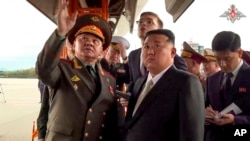Depending on what kinds of weapons technology Moscow transfers to Pyongyang, the United States and South Korea may need to update their measures for dealing with North Korean threats, said analysts.
John Kirby, White House National Security Council spokesman, said the U.S. is watching “very closely” as North Korean leader Kim Jong Un pursues advanced military capabilities from Russian President Vladimir Putin.
Kirby said at a press briefing on Tuesday that Kim’s ability to benefit from this relationship is concerning, but the U.S. and South Korean defensive posture on the Korean Peninsula “is appropriate to the risk.”
Since July, when Russian Defense Minister Sergei Shoigu visited North Korea, Pyongyang has been deepening its military ties with Moscow while escalating threats on the peninsula and calling for preparations to occupy South Korea if war breaks out.
North Korea fired cruise missiles into the waters off its western coast on Wednesday, according to South Korea’s Joint Chiefs of Staff. It also began taking down a monument in Pyongyang symbolizing reunification with South Korea.
Putin and North Korean Ambassador Choe Son Hui discussed bilateral relations in Moscow on January 16, according to Tass, the Russian state-owned news agency. It quoted Kremlin spokesperson Dmitry Peskov the next day saying Moscow and Pyongyang “intend to boost relations in all areas, including sensitive ones.”
The most worrisome technology North Korea could seek from Russia would enable Pyongyang to miniaturize nuclear warheads to fit into a ballistic missile cone, survive reentry and hit targets in South Korea, Japan and North America, said Robert Peters, a fellow for nuclear deterrence and missile defense at the Heritage Foundation.
“This technology is the last and the most critical step in North Korea fielding a credible nuclear strike capability and is well within Russia’s ability to share,” Peters told VOA via email.
He continued, “South Korea and the United States should prepare to face a North Korea that is technically more capable than it has been before.”
At an event in Washington hosted by the Center for Strategic and International Studies on January 18, Pranay Vaddi, the National Security Council’s senior director for arms control and nonproliferation, warned that the North Korean threat “could drastically change over the coming decade” as a result of military cooperation with Moscow.
“What we are seeing between Russia and North Korea is an unprecedented level of cooperation in the military sphere,” Vaddi said.
Last year, Putin turned to North Korea to replenish Russia’s weapons stockpile, which has been drawn down severely since the invasion of Ukraine in February 2022. He met with Kim in Russia in September to discuss possible arms dealings.
In October, Washington released satellite photos showing North Korea shipping more than 1,000 containers of weapons to Russia in violation of sanctions.
Artillery and missiles North Korea provided to Russia have been turning up in Ukraine, The New York Times reported on Monday.
John Erath, senior policy director for the Center for Arms Control and Non-Proliferation, said Russian technology transfers “would not so much change the threat as add to the atmosphere of tension on the peninsula.”
But he told VOA via email, “It will be important to keep defense and deterrence arrangements updated.”
In November, the U.S. and South Korea held an annual Security Consultative Meeting in Seoul, where they announced the revision of the 2013 Tailored Deterrence Strategy “in recognition of the changing security environment.
Their meeting followed a summit that U.S. President Joe Biden and South Korean President Yoon Suk Yeol held in April in Washington, where they announced the Washington Declaration aimed at strengthening nuclear deterrence on the Korean Peninsula.
Gary Samore, White House coordinator for arms control and weapons of mass destruction during the Obama administration, said in a telephone interview that weapons technology Pyongyang could obtain from Moscow could embolden it to raise threats but would not be a game changer requiring the revision of “fundamental deterrence” on the Korean Peninsula.
Samore, a professor at Brandeis University, thinks Pyongyang could seek enhanced technology to include surface-to-air missiles, spy satellite collection capabilities and advanced military fighter aircraft.
He told VOA that although Moscow would be “happy whenever there is trouble for the U.S.,” it would not encourage Pyongyang to cause conflict on the Korean Peninsula that would “jeopardize the flow of weapons to Russia” for its war in Ukraine.
